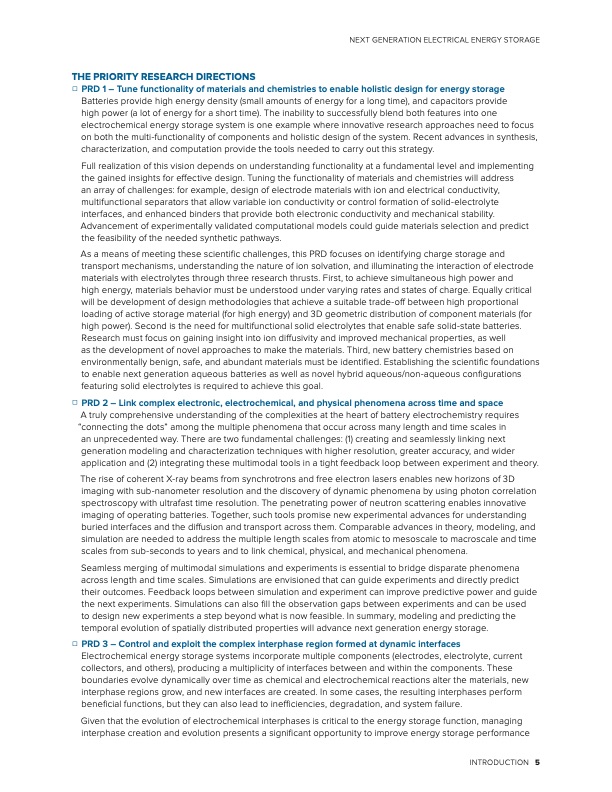
PDF Publication Title:
Text from PDF Page: 011
THE PRIORITY RESEARCH DIRECTIONS ☐ PRD 1 – Tune functionality of materials and chemistries to enable holistic design for energy storage Batteries provide high energy density (small amounts of energy for a long time), and capacitors provide high power (a lot of energy for a short time). The inability to successfully blend both features into one electrochemical energy storage system is one example where innovative research approaches need to focus on both the multi-functionality of components and holistic design of the system. Recent advances in synthesis, characterization, and computation provide the tools needed to carry out this strategy. Full realization of this vision depends on understanding functionality at a fundamental level and implementing the gained insights for effective design. Tuning the functionality of materials and chemistries will address an array of challenges: for example, design of electrode materials with ion and electrical conductivity, multifunctional separators that allow variable ion conductivity or control formation of solid-electrolyte interfaces, and enhanced binders that provide both electronic conductivity and mechanical stability. Advancement of experimentally validated computational models could guide materials selection and predict the feasibility of the needed synthetic pathways. As a means of meeting these scientific challenges, this PRD focuses on identifying charge storage and transport mechanisms, understanding the nature of ion solvation, and illuminating the interaction of electrode materials with electrolytes through three research thrusts. First, to achieve simultaneous high power and high energy, materials behavior must be understood under varying rates and states of charge. Equally critical will be development of design methodologies that achieve a suitable trade-off between high proportional loading of active storage material (for high energy) and 3D geometric distribution of component materials (for high power). Second is the need for multifunctional solid electrolytes that enable safe solid-state batteries. Research must focus on gaining insight into ion diffusivity and improved mechanical properties, as well as the development of novel approaches to make the materials. Third, new battery chemistries based on environmentally benign, safe, and abundant materials must be identified. Establishing the scientific foundations to enable next generation aqueous batteries as well as novel hybrid aqueous/non-aqueous configurations featuring solid electrolytes is required to achieve this goal. ☐ PRD 2 – Link complex electronic, electrochemical, and physical phenomena across time and space A truly comprehensive understanding of the complexities at the heart of battery electrochemistry requires “connecting the dots” among the multiple phenomena that occur across many length and time scales in an unprecedented way. There are two fundamental challenges: (1) creating and seamlessly linking next generation modeling and characterization techniques with higher resolution, greater accuracy, and wider application and (2) integrating these multimodal tools in a tight feedback loop between experiment and theory. The rise of coherent X-ray beams from synchrotrons and free electron lasers enables new horizons of 3D imaging with sub-nanometer resolution and the discovery of dynamic phenomena by using photon correlation spectroscopy with ultrafast time resolution. The penetrating power of neutron scattering enables innovative imaging of operating batteries. Together, such tools promise new experimental advances for understanding buried interfaces and the diffusion and transport across them. Comparable advances in theory, modeling, and simulation are needed to address the multiple length scales from atomic to mesoscale to macroscale and time scales from sub-seconds to years and to link chemical, physical, and mechanical phenomena. Seamless merging of multimodal simulations and experiments is essential to bridge disparate phenomena across length and time scales. Simulations are envisioned that can guide experiments and directly predict their outcomes. Feedback loops between simulation and experiment can improve predictive power and guide the next experiments. Simulations can also fill the observation gaps between experiments and can be used to design new experiments a step beyond what is now feasible. In summary, modeling and predicting the temporal evolution of spatially distributed properties will advance next generation energy storage. ☐ PRD 3 – Control and exploit the complex interphase region formed at dynamic interfaces Electrochemical energy storage systems incorporate multiple components (electrodes, electrolyte, current collectors, and others), producing a multiplicity of interfaces between and within the components. These boundaries evolve dynamically over time as chemical and electrochemical reactions alter the materials, new interphase regions grow, and new interfaces are created. In some cases, the resulting interphases perform beneficial functions, but they can also lead to inefficiencies, degradation, and system failure. Given that the evolution of electrochemical interphases is critical to the energy storage function, managing interphase creation and evolution presents a significant opportunity to improve energy storage performance NEXT GENERATION ELECTRICAL ENERGY STORAGE INTRODUCTION 5PDF Image | Next Generation Electrical Energy Storage

PDF Search Title:
Next Generation Electrical Energy StorageOriginal File Name Searched:
BRN-NGEES_rpt-low-res.pdfDIY PDF Search: Google It | Yahoo | Bing
Sulfur Deposition on Carbon Nanofibers using Supercritical CO2 Sulfur Deposition on Carbon Nanofibers using Supercritical CO2. Gamma sulfur also known as mother of pearl sulfur and nacreous sulfur... More Info
CO2 Organic Rankine Cycle Experimenter Platform The supercritical CO2 phase change system is both a heat pump and organic rankine cycle which can be used for those purposes and as a supercritical extractor for advanced subcritical and supercritical extraction technology. Uses include producing nanoparticles, precious metal CO2 extraction, lithium battery recycling, and other applications... More Info
| CONTACT TEL: 608-238-6001 Email: greg@infinityturbine.com | RSS | AMP |